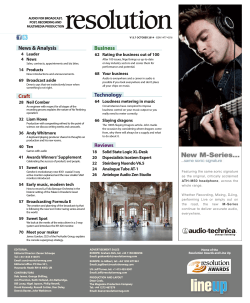
Link to poster - K-Lab
A Review of the Components Used in Video Packages Candice Hansard, Shir Zion, & Ellie Kazemi California State University, Northridge Results Introduction Using videos to train staff has advantages • Maximizing trainer/supervisor time • Deliver consistent training for large amounts of individuals 40 15 35 1 1 30 Published between 2000-2014 25 20 15 10 N = 95 N = 35 10 13 10 8 6 4 4 0 3 Video + Training 3 3 Models Models + Audio Behavioral Procedure Analysis Models + Audio + Written instruction Models + Audio + Written instruction + Test Models + Written instruction Models 11 9 Effective 18 12 0 15 7 14 2 Video Alone Not Effective 16 5 Models + Audio 10 10 Models + Audio + Written Instruction 9 Models + Audio + Written Instruction + Test 7 6 5 Models + Written Instruction 4 4 3 3 3 3 3 3 3 1 -1 Functional Analysis Intervention included a video 32 30 Number of Participants (N=45) Journal of Applied Behavior Analysis 20 18 Methods All text search using Google Scholar • Video* AND Staff AND “Train* OR Teach* OR Acquisition” Effectiveness of Video Components Number of participants (N=45) Purpose • To conduct a review of the literature on video package interventions • To identify the commonly used components in videos • To identify which of those were most effective 45 Number of partiipants (N= 78) Unclear what components an effective video must contain; this poses potential problems (e.g., ineffective training) Effectiveness of Training that Used Videos 15 Preference Assessments Discrete-Trial Instruction Escape Extinction N = 19 Differential Reinforcement Functional Communication Training Safe Lifting Behaviors Discussion Participants included students, staff, and/or teachers Evaluated mean accuracy of performance during intervention for each participant N = 14 Summary of Effective Videos Videos + Training • More effective compared to videos that were used alone N= 78 Definitions of Effectiveness Effective • mean accuracy of performance during intervention was 80% or above Not Effective • mean accuracy of performance during intervention was below 80% Video Alone • Models + Audio Most often used 100% effective • Behavior Procedures Preference Assessments Discrete- Trial Instruction Escape Extinction Differential Reinforcement Functional Communication Training • Models + Written Instruction 100% effective • Behavioral Procedures Preference Assessments Future Research • Review of training used to supplement video packages (e.g., dependent variables, components of training) • Experimental analysis of video training Selected References Catania, CN., Almeida, D., Liu‐Constant, B. (2009). Video modeling to train staff to implement discrete-trial instruction. Journal of Applied Behavior Analysis, 42, 387-392. DOI: 10.1901/jaba.2009.42-387 Digennaro-Reed, F.D., Codding, R., Catania, C.N., Maguire, H. (2010) Effects of video modeling on treatment integrity of behavioral interventions. Journal of Applied Behavior Analysis, 43, 291-295. DOI: 10.1901/jaba.2010.43-291 Howard, V.J., Reed, F.D.D. (2014). Training shelter volunteers to teach dog compliance. Journal of Applied Behavior Analysis, 47, 344-359. DOI: 10.1002 jaba.120
© Copyright 2025










